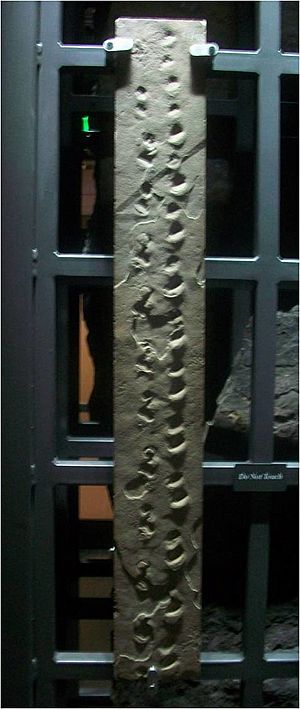Corncockle Quarry facts for kids
Corncockle Quarry was once a very large and important sandstone quarry in Scotland. It was located near a place called Templand in Dumfries and Galloway. Stone from this quarry was used a long time ago, during the late Victorian era, to build many buildings.
For example, it helped create tall apartment buildings called tenements in cities like Edinburgh and Glasgow. It was also used to build famous brown-colored houses in New York City, known as 'brownstones'.
Contents
What is Corncockle Quarry?
Corncockle Quarry is a place where people dug out a type of rock called sandstone. This sandstone is part of what scientists call the Corncockle Sandstone Formation. It's incredibly old, dating back to the Lower Permian period, specifically the Cisuralian age. This means the rock formed between 298.9 and 272.3 million years ago!
Amazing Ancient Footprints
While workers were digging for stone in the early 1800s, they found something amazing: fossil footprints! These ancient prints were often mistakenly called dinosaur footprints. However, dinosaurs hadn't even appeared on Earth yet during the Permian period.
So, whose footprints were they? They belonged to other types of ancient reptiles. These included animals called therapsids. Therapsids were a special group of reptiles that eventually led to the development of mammals, like us! An example of an animal from this group is Dimetrodon.
Who Discovered the Footprints?
The fossil footprints found at Corncockle Quarry were the first of their kind to be studied scientifically. Mr. J Grierson and a minister named Reverend Henry Duncan first described them in 1828. Reverend Duncan then wrote a detailed paper about these footprints, which was published in 1831.
The Study of Footprints
The scientific study of fossil footprints and other ancient marks left by animals is called ichnology. This name was actually created by Sir William Jardine. He wrote a book called The Ichnology of Annadale, which was all about the trackways found right there in Corncockle Quarry. This quarry was part of his family's land. Later, another scientist named William Buckland also described these important prints after talking with Reverend Duncan.
Today, you can see some of these incredible fossil footprints! They are on display at the Dumfries Museum and the National Museum of Scotland in Edinburgh.
Quarry's Commercial Use
The stone from Corncockle Quarry was very popular. At its busiest time, the quarry even had its own special railway line. This line connected it to the main Caledonian Main Line, making it easy to transport the heavy stone.
Today, the quarry is known as Dunhouse Quarry. The company Dunhouse still extracts stone from this historic site.
Images for kids



